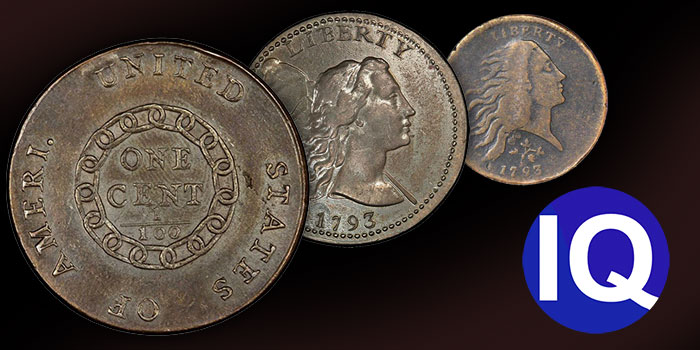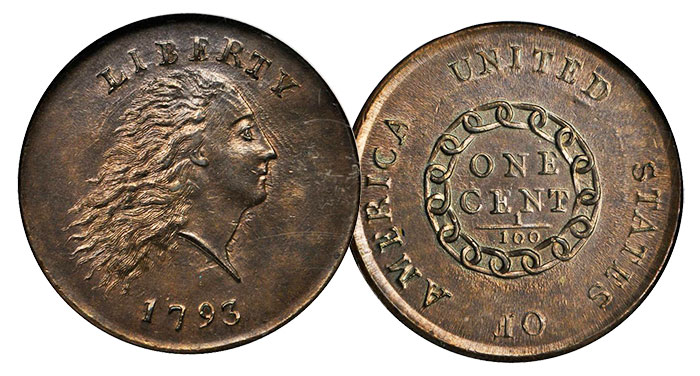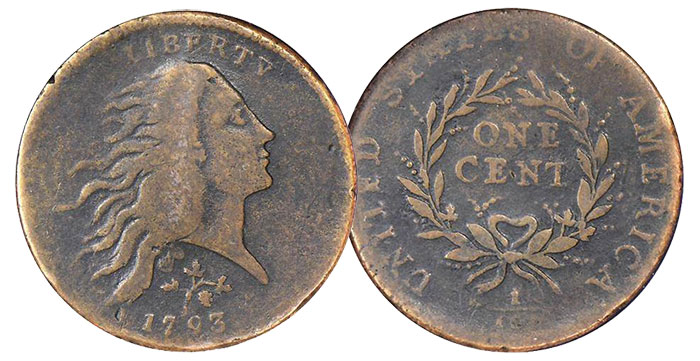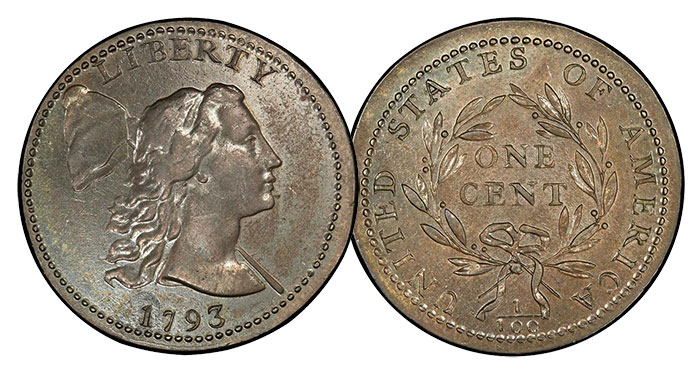
By Lianna Spurrier for CoinWeek …..
The Flowing Hair cent of 1793, along with the half cent, were the first coins mass-produced by the United States Government on its own property. As such they are widely studied and collected, which has resulted in a wealth of knowledge about minor die varieties for the early issues.
For those unacquainted with early large cents, the Flowing Hair designation can be a conundrum.
Three unique designs fall under this umbrella, with drastic changes made to both sides across the three. What’s more, all three were minted at some point in 1793–and that’s without even mentioning varieties, such as the Chain Ameri. cent or the Jefferson Head.
It’s possible to get quite deep into research about specific die pairings and die states, but before diving into anything too technical, it’s helpful to have an overview of the different designs.
Chain Cents
Before minting any coins, the U.S. Mint needed to hire an engraver. The most qualified man to be found was Henry Voigt, hired as Chief Coiner in 1792.
Voigt worked at a mint in Germany when he was younger, but engraving was not his main occupation; he applied for the job as a way to pay the bills while he worked on perfecting the steamboat. He may have been the best option available, but he didn’t have the skills necessary to create intricate designs.
The first large cents struck for circulation were minted on February 27, 1793. The obverse depicts Lady Liberty with her hair flowing, which was widely criticized. Instead of appearing elegant and free as Voigt had hoped, people thought she looked disheveled and crazy. In addition, they were designed with a plain lip border that wore off easily and was commonly lost altogether on undersized or off-center planchets.

The reverse was no better received. It featured “One Cent” in the center, accompanied by the fraction 1/100. Many people in the US couldn’t read, but most knew numerals. This was encircled by a chain of 15 links with “United States of America” around the edge. The idea was that the chain would represent the unity of the 15 states, but many people associated it with slavery. On the edge was an engraving of a vine and bars. These became known as Chain cents, thanks to the reverse design.
There were three major varieties of this type. The first variety, the “Chain Ameri.,” was the first group struck. The same obverse die was later used with another reverse, and the die states make it clear that the Ameri. cents were struck first. On the reverse, America is abbreviated to Ameri., seemingly because the engraver ran out of room to spell it out. Had the word been completed, it would have come very close to the beginning of “United.” The legends were engraved by hand with punches, so it would have been easy to misjudge the spacing.

The second and most valuable variety has mysterious periods after “Liberty” and the date on the obverse. It’s not known why these were added, but only 325 are believed to survive and the auction record was set in 2012 by a PCGS MS65 example that sold for $1.38 million USD. This is the highest auction price for a large cent and was only the second of this denomination to sell for over $1 million.
The third variety is the “norm”: “America” is spelled out and there are no periods. Altogether, Chain cents were only minted for about two weeks from February 27 to March 12. Between the three main varieties, a total of 36,103 were minted for circulation, and only around 1,000 are believed to survive today.
Interestingly, there is a single specimen strike known of both the Chain Ameri. cent and the Period variety. Neither has been sold since 1992, and both are certain to set new records the next time they cross the auction block.
Due to the Chain cent’s high desirability as the first circulating cent made at the US Mint, even an example of the most common variety in PO01 will go for around $2,000.
Wreath Cents
The public so strongly disliked the chain reverse that it was redesigned by April of 1793. Instead of a chain, Wreath cents have – as one would assume – a wreath encircling the denomination on the reverse. Little was done to address the “crazed” look of Lady Liberty, but a plant was added beneath the bust. The plain lip was traded for a beaded border that caused fewer problems.
Wreath cents were struck from April 4 to July 17, resulting in a little less than twice the mintage of Chain cents. There were three major varieties of these as well, two resulting from the edge treatment. Some were minted with the same vine and bars edge as the Chain cent, while others were inscribed “One hundred for a dollar.” These two are very similar in value, with the lettered edge averaging just slightly higher.

The rarity of this design is known as the Strawberry Leaf variety, of which only four are known. These inexplicably have a very different style leaf below Liberty’s bust on the obverse that resembles a strawberry leaf. The finest known example is only F12 and last sold in 2009 for $862,500.
Around 2,500 total Wreath cents are thought to survive, and they are significantly cheaper than Chain cents; the $2,000 that would only get you a PO01 example of a Chain cent would likely cover a common variety of Wreath cent around G04.
The wreath design was received much better than the chain, though there has been considerable debate about exactly which plants are represented in it. Regardless, the wreath cent was not without its problems; dies broke easily because Eckfeldt, the die sinker, hadn’t figured out how to fully harden them. In addition, the wild-eyed Lady Liberty hadn’t been changed from the original issue.
Over the summer of 1793, the Mint hired Joseph Wright, a portrait painter. He was tasked with making new device punches, and therefore a new design.
Liberty Cap Cents
Joseph Wright left the reverse virtually unchanged, but Lady Liberty’s portrait was significantly modified. Her hair was smoothed and shortened, and a Phrygian cap on a pole was added behind her. This design was significantly longer-lived than its predecessors, lasting from late 1793 through mid-1796.

1793 saw only one major variety, which had a beaded border like the Wreath cent. This was switched in 1794 for a denticle border. This change, however, was made by Robert Scot; Joseph Wright died in September of 1793, probably of yellow fever. Robert Scot was hired to take Wright’s place and ultimately to become the first Chief Engraver. He was an engraver by trade who had previously engraved plates for maps and paper money.
There are many major varieties in this series, the most valuable of which is the 1795 Reeded Edge. That year the weight was reduced, which led to thinner planchets and resulted in three different edge treatments: lettered, plain, and reeded. Only nine Reeded Edge examples are known, and a VG10 example became the first large cent to sell for over $1 million in 2009.
This record-breaking price was partially due to a 1949 book by Dr. William Sheldon. In Early American Cents (1949), he grouped coins into collectible and non-collectible categories – in other words, collectible coins are what constitute a full set, whereas non-collectible pieces are considered too rare to be required.
The 1795 Reeded Edge is the rarest cent deemed collectible by Sheldon, therefore driving up prices as collectors want to complete their sets. This led to significant competition, therefore driving up the price. In recent years, some coins classified as non-collectible by Sheldon have actually become more available than the Reeded Edge, but his numbering and classification system is still used today.
Another interesting variety is the Jefferson Head of 1795, which wasn’t actually produced by the US Mint.
John Harper was a machinist who approached the Mint wanting to strike coins for them on contract because he believed his techniques were superior. When he was turned away, he set about striking examples to prove his techniques worked. Engraving, however, was not his strong suit. So while he made a valiant effort, his dies are easily distinguishable from Mint-issued cents. They are most clearly identified by a curl that winds backward at the bottom of Liberty’s bust, toward her face.
These pieces usually have surface issues due to improper annealing of the blank planchets. They typically come with a plain edge, but three examples are known with a lettered edge. However, both are extremely rare and are more expensive than most issues in the series.
A rather perplexing variety is the 1794 Starred Reverse. Around the reverse edge, overlapping the denticles, is a circle of 94 tiny stars. This unique reverse die buckled early in its life, resulting in an estimated 60 surviving examples. The highest-graded example from PCGS is only in AU50, which last sold in 2008 for $632,500.
The common varieties are less expensive than either of the previous issues. The same $2,000 mentioned above would cover a Liberty Cap cent around VF20 for a common issue, such as the 1794 Head of 1794 or the 1795 Plain Edge.
* * *
For all of these designs, there is extensive research into die pairings. Experts collect them by individual die pairs as opposed to these broad varieties, but they give you a glimpse into the different major issues. There are plenty of resources available to help anyone learn more about these early issues from a fascinating time in the Mint’s history.




